Home » Fossils » Understanding Past Climate and Ecosystems
Understanding Past Climate and Ecosystems
A case study from the Mio-Pliocene deposits at the West Coast Fossil Park, South Africa
by Alexandra Guth, Michigan Technological University
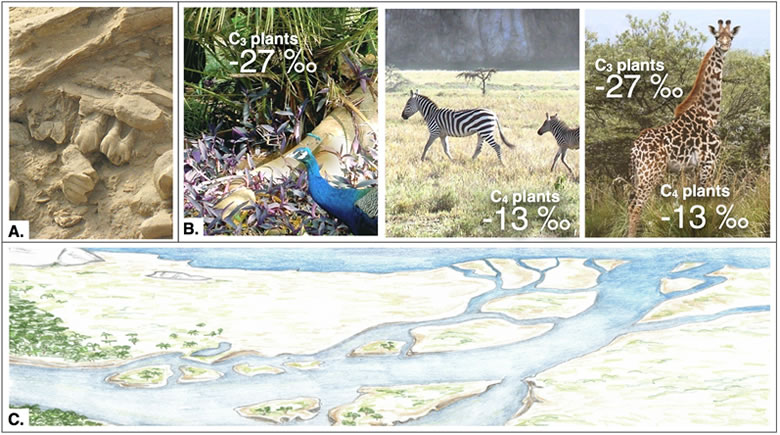
Reconstructing an environment: Scientists combine many pieces of evidence in order to understand Earth's past. Fossils (A) show specifically which animals lived in a region, while the sediments surrounding the bones provide important clues about the depositional setting. Bones can be further analyzed for their isotopic compositions, which is influenced by what plants the animal consumed while alive (B). Additionally, pollen released from plants tends to be readily preserved in the geologic record, providing a detailed record of past floral communities. All of these bits of evidence can be combined to create detailed reconstructions of environments that existed millions of years ago (C).
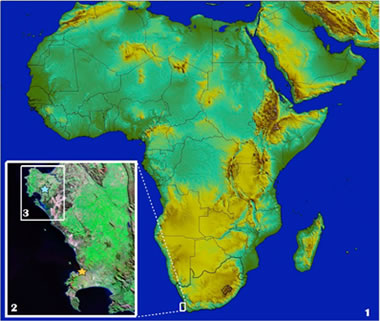
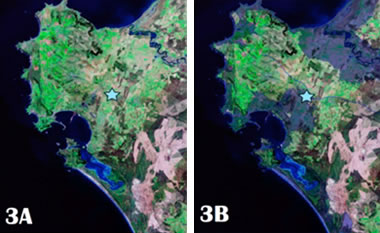
West Coast Fossil Park: Location map showing the elevation of Africa (1) with the Western Cape region of South Africa (2) expanded. On map 2, the southern orange star is the location of Cape Town, and the northern blue star represents the West Coast Fossil Park. The subset region 3 is expanded to show the present sea level conditions (3A) and the situation 5.2 million years ago, when sea level was ~ 30 meters higher than present (3B). At that time, the site occupied by the fossil park would have been near the coast where the ancient Berg River emptied into the Atlantic. Elevation of Africa basemap is from the CleanTOPO2 data set, and satellite imagery is NASA's Landsat GeoCover circa 2000.
Introduction
How do we know what the ancient Earth was like before people were around to witness and record conditions? One of the main ways geoscientists unravel past climates and ecosystems is by conducting detailed studies of deposits that contain the preserved remains of ancient plants and animals.
The formation of fossils is generally a rare occurrence, so finding pockets of concentrated, or highly detailed, fossil remains is scientifically valuable. Fossil deposits notable for their diversity or detail are called Lagerstätten (German for ‘motherlode’ or ‘storage place’), which can be divided into two main types.
Konservat-Lagerstätten are locations where the fine details of an organism are conserved (note the similarity between the German and italicized English equivalent). In such sites the soft parts of an organism, which normally decay, are recorded as impressions or carbon films. Well-known examples of such deposits are the Burgess Shale in British Columbia and the Green River Formation in the Western US.
The second variety is the Konzentrat-Lagerstätte, which is a location where there is a large concentration of bones. While these sites do not provide many fine details of the organisms, they can provide a glimpse of an ancient ecosystem by concentrating the bones of animals that would normally be spread across a wide area. Examples include the Jurassic-aged Morrison Formation exposures at Dinosaur National monument in Utah, and the 15-16 million year old Sharktooth Hill Bone Bed in California.
Another example of a Konzentrat-Lagerstätten is found in the sediment deposits of the Langebaanweg Formation in the West Coast Fossil Park in South Africa. The numerous remains within these fossiliferous beds provide important information about the biologic communities and climate of the region around 5 million years ago.
Site Discovery & Development
Originally a phosphate mine, the fossils were discovered in the late 1950’s. Phosphates are mined today mainly for their use in fertilizers, and phosphoric acid is commonly used in soft drinks. These rocks however, were initially mined for use in World War II armaments.
Sedimentary phosphate deposits are produced in regions of high marine biologic productivity, like the modern continental shelves. Due to changing conditions, sea level in this case, regions previously underwater are now exposed on land and accessible for detection and excavation. Active mining at the fossil site ceased in 1993 when the mine closed, and the area where fossils had been discovered was set aside as a National Monument (soon to become a National Heritage Site). Mining activity may have destroyed 80% of the fossils at this site, but there are still an estimated 1 million specimens preserved in the collections of the Iziko South African Museum.

Phosphatic rock with organic material: A centimeter-scale next to phosphatic rock. The red grains represent the phosphatized organic material. Photo by Alexandra Guth.
Forming a Konzentrat-Lagerstätte
It is common to visualize the fossilization process as a single animal dying and then being buried in place. While some animals died directly on the floodplains that used to exist at the site, many of the remains at the West Coast Fossil Park were moved and concentrated by water in this single location over time.
Likely the ‘ancestor’ of the Berg River emptied into the Atlantic near the present-day park when the bones were deposited. An offshore sand bar may have kept the remains from being flushed out to sea, and may have also simultaneously acted to trap remains washed in from the ocean.

Reconstructing an Environment
Different animals and plants have varied habitat needs; thus, identifying the remains to establish what community is present provides clues about past ecosystems. This task becomes more difficult for deposits that represent an entirely extinct fauna (like the dinosaurs of the Jurassic Morrison formation), but the remains at the West Coast Fossil Park are a ‘mere’ 5 million years old. While most of the species preserved at the park are extinct themselves, they are closely related to modern species.
In terms of identifying an animal you do not need 100% of an individual’s bones to confidently identify it. This is particularly important, as whole skeletons are not commonly found, especially in Konzentrat-Lagerstätten where the bones have been disarticulated and transported. There is often an additional preservation bias, where small delicate bones are destroyed during transport, while thicker and sturdier bones are more likely to remain intact. Despite these difficulties, paleontologists are quite successful at classifying and identifying bones to picture the ancient community.
The animals found at the West Coast Fossil Park indicate that the area was near the boundary of land and ocean, given that both marine animals (e.g. seal, megalodon shark, 4 species of penguin) and land mammals (e.g. short-necked giraffe, aardvark, hyena, hippo, mammoth, antelope, three-toed horse, saber-toothed cat) were found together. The additional presence of frogs (at least 8, maybe as many as 12 species are represented in the deposits) indicates that there must have been standing fresh water. While many frog species exhibit some tolerance to saline water, there are no known amphibians that inhabit purely marine habitats.
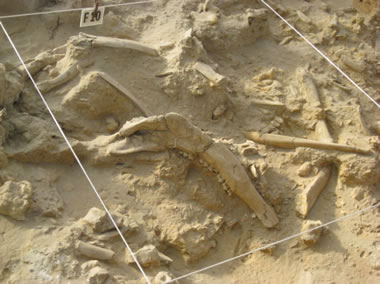
Bone bed: The in-situ bone bed displayed at the West Coast Fossil Park, South Africa. The jaw bone in the center belonged to a Sivathere, an extinct relative of the modern giraffe. The string marks out a 1-meter grid.
Carbon Isotopes: More than just age dating
A more detailed understanding can come from examining the carbon isotopes preserved in bones and teeth. While most people are familiar with the C-14 isotope due to its use in dating recent remains (see discussion below), carbon has two isotopes that are more common, and not radioactive. C-12 is the most common isotope of carbon, with C-13 being a secondary stable isotope. Because they are stable, they do not decay over time.
Different plant groups have distinct ratios of carbon isotopes that can be used as a fingerprint for paleodiet of ancient animals. The carbon in plants is used to build bone and teeth, such that the ratios in the plants are reflected in the bones of the animals that consume them.
These different isotopic signatures are due to the different metabolic pathways used by plants. Many grasses are geologically recent and are “C4 plants,” while trees and herbaceous plants are “C3 plants”. A savannah is composed of both C4 and C3 plants as there are trees, shrubs, and grasses. A forest on the other hand, will be predominantly C3 plants. A flora unique to South Africa is the fynbos (pronounced: “finebose”), which is also C3.
An animal that consumes mostly C3 plants will have a different carbon isotope ratio in its bones than an animal that mostly eats C4 plants. Analysis done on the remains of ungulates (hoofed mammals: hippos, antelope, giraffe, pigs, etc...) indicate that the environment present at the fossil park 5 million years ago was dominated by C3 plants.
Pollen
While the isotopic analysis indicated that the region was not dominated by grasses, it could not differentiate between trees, shrubs and fynbos. Fortunately pollen released by plants is typically abundant and well preserved in sediments.
Pollen, unlike isotope ratios, can uniquely identify a plant family or genus that was present in the area. As an additional bonus, unlike larger plant remains like wood or leaves, pollen is easily carried by wind and water and is thus spread widely from an individual plant’s location. While you may never find a fossil leaf from an individual plant, you are much more likely to find its pollen.
Pollen analysis at the Fossil Park indicates that the region 5 million years ago included the herbaceous Ranunculaceae (e.g. buttercups), Cyperaceae (sedges, e.g. papyrus), Asteraceae (e.g. daisies), and Umbelliferae (e.g. parsley, Queen Anne’s lace) plant families. The combination of these botanical families were used to infer a coastal plain habitat. The presence of the Asteraceae, Chenopodiaceae (goosefoot) and Amaranthaceae (amaranth) plant families additionally indicated drier conditions. Pollen from trees of the Proteaceae family (e.g. protea), as well as the Podocarpus (e.g. yellowwood) and Olea (e.g. olive and ironwood) genera was also present.
The presence of all of this pollen provides a picture of the plant communities that inhabited this region at the time the fossiliferous sediments were deposited. Knowing which plants and animals were present at the time can then be used to indicate the past environment.
The Goldilocks Age Dating Problem
Carbon-14 is the (naturally occurring) radioactive isotope of carbon that is the most popularly known method for dating old materials. However, the vast majority of the rock record cannot be dated with this technique because the half-life of C-14 is too short, and it also requires the presence of the original organic material (whereas, fossilization replaces the original organic material with more durable minerals). By the time organic material is 75,000 years old, there is too little C-14 left in the sample to reliably measure.
The radioactive isotope of potassium (K-40) has a much longer half-life than C-14 and is present in igneous rocks. Thus, techniques involving Potassium and its daughter product Argon, can be used on materials that were erupted from volcanoes more than 100,000 years ago (because the half-life is so long, this technique cannot be used on very young material because such a small fraction of the original potassium has decayed that we can’t accurately measure it).
Unfortunately, South Africa was not volcanically active during the time these animals died, so the sediments cannot be dated directly using potassium-argon. However, other methods involving patterns of sea level change, paleomagnetism, and fossils can be used to indicate the age of the sediments.
Linking Ages with Fossils
Biostratigraphy is a method of ordering the rock record based on the animal remains present, and is a useful alternative for providing age constraints on fossiliferous rocks. Some animal lineages like the pigs and elephants, seem to change rapidly (in a geologic sense), so identifying different sets of these animals can help pinpoint the age of the rocks.
Clues from fossil animals constrain the age of the West Coast Fossil Park sediments to around 5.2 million years ago. The suid (pig) Nyanzachoerus kanamensis has been found in both East Africa and at the fossil park. Due to the active rifting and associated volcanic activity in East Africa, an absolute age date (as in, we can pin a number to it), has been associated with that species. Since the pig family was experiencing geologically rapid changes, by finding that species we can say something about the age of the sediments at the park.
| More Information |
|
[1] Isotope Analyses and the Histories of Maize: Robert H. Tykot, Chapter 10 in: J.E. Staller, R.H. Tykot and B.F. Benz (editors), Histories of Maize: Multidisciplinary Approaches to the Prehistory, Linguistics, Biogeography, Domestication, and Evolution of Maize, Academic Press (Elsevier), 2009.
[2] The Rocks and Minerals of Cape Town: J.S. Compton, Double Storey Books, Cape Town, South Africa, 112 pages, 2004. [3] CleanTOPO2: Edited SRTM30 Plus World Elevation Data: by Tom Patterson of the US National Park Service; published on GISuser.com. [4] Regional and global context of the Late Cenozoic Langebaanweg (LBW) palaeontological site: West Coast of South Africa: David L. Roberts, et al., Earth-Science Reviews, Volume 106: 3-4, pages 191-214, 2011. [5] The Environment 5-5.2 Million Years Ago: article on the West Coast Fossil Park website, last accessed July 2022. |
Conclusions
Reconstructing an environment can often come down to fine details: isotopic signatures in bones, microwear patterns on teeth (scratches on the surface of the teeth can indicate if the animal was a grazer, browser, or mixed-mode feeder), pollen assemblages in sediments, etc...
At the moment, the park exists in a Mediterranean climate and is located over 10 km from the ocean. All of the combined evidence however, indicates that five million years ago the West Coast Fossil Park would have existed in a subtropical woodland near where an ancient Berg River emptied into the Atlantic.
Animal remains combined with microscopic and chemical clues create a cohesive picture of what this region was like even though no human was around to witness it directly. It is in this manner that geoscientists unravel the mysteries of Earth’s past life and climate.
Today, these fossils can be seen in situ (in place) at the West Coast Fossil Park in South Africa, and guests can even help complete the environmental picture by looking for microfossils of birds, frogs, rodents, and many other small animals on sieve screens. Any finds are added to the museum collections – visitors are not permitted to collect specimens for themselves, as all fossils are protected by the state in South Africa.
| West Coast Fossil Park |
The West Coast Fossil Park is located 120 km north of Cape Town in South Africa. Their website contains abundant information about the site, detailed directions, information regarding research happening there, as well as educational animations and worksheets. The author of this article would like to thank the manager of the Fossil Park, Pippa Haarhoff, for her help and encouragement.
About the Author
Alex Guth is a PhD graduate from Michigan Technological University, and her dissertation focused on the volcanic evolution of the Kenya Rift. She has visited the Western Cape region of South Africa several times to assist her advisor with geology field camp, and her research in Africa has led to several opportunities to work with National Geographic. Her website can be viewed at: https://pages.mtu.edu/~alguth/
| More Fossils |
 |
Animal Fossils |
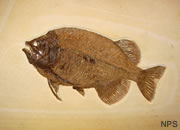 |
Fossil Fish |
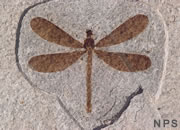 |
Insect Fossils |
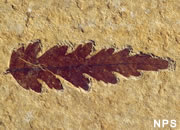 |
Plant Fossils |
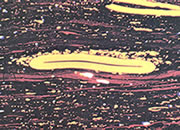 |
Coal Through a Microscope |
 |
Turritella Agate |
 |
Jet |
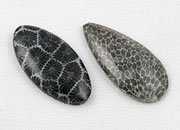 |
Fossil Gems |

Find Other Topics on Geology.com:

|

| ||

|

| ||

|

| ||

|

|
